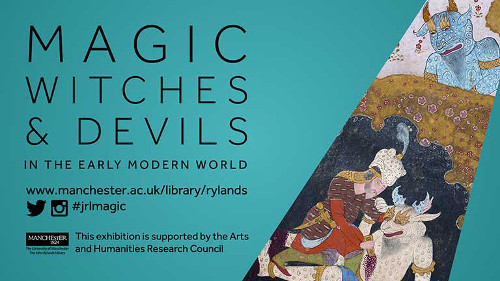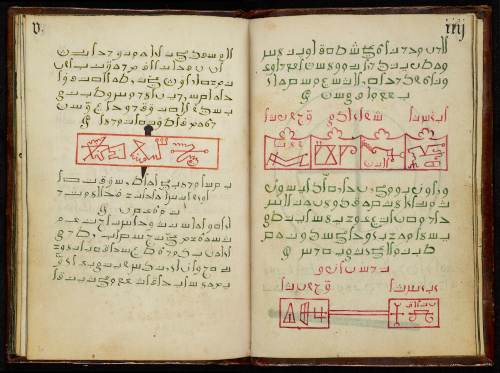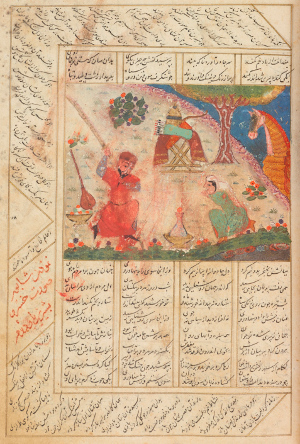
This fascinating exhibition, housed within the gothic splendour of The John Rylands Library in Manchester, reveals how magic, diabolical witchcraft and ghostly encounters inspired fear and curiosity on an unprecedented scale between the 15th and 18th centuries. With stunning local, European and non-Western examples from Manchester collections, the exhibition offers an exceptionally wide-ranging window onto the supernatural world. Curated by historians Jennifer Spinks and Sasha Handley from the University of Manchester, the exhibition presents rare books, prints, manuscripts and objects that illuminate the roots of our obsession with supernatural powers and reveal a world where the Devil was understood as a very real and present danger in daily life.
The exhibition draws on the collections of the John Rylands Library, the Whitworth Art Gallery and Chetham’s Library which contain many rare books, prints, manuscripts and protective amulets that provide unique perspectives on how early modern people feared, engaged with, and sometimes found pleasure in the supernatural world. The years c.1400- c.1800 coincided with major changes in European society, from scientific developments to religious conflicts to a great increase in the number of printed publications. One of the most important changes was increasing contact with other lands. Although the exhibition focuses principally on Europe, it also includes examples of how some non-Western traditions represented and tapped into powers beyond the everyday.

Pseudo-Michael Scot. Franconia, Germany, late 16th century (Latin MS 105).
The Compendium was attributed to the astrologer Michael Scot, whose infamy as a supposed magician was noted even by the famous Italian poet Dante. Intriguingly, the Scot manuscript contained strange elements of Arabic artifice. What appears to be a copy of an earlier spell, transcribed into corrupted or fake Arabic, was included as a precursor to its Latin ‘translation’. This was evidently designed to lend a sense of mystery as well as credibility to the conjurations contained within the book.

The Shahnama (Book of Kings) was an epic poem that detailed Persian history from the beginning of the world to the arrival of Islam. It appeared in many manuscript editions and generated a vibrant artistic tradition. The story of Rustam’s fourth task saw the hero enter a land populated by demons and sorcerers, where he was approached by a witch in the guise of a beautiful young woman. Realising her true nature when she recoiled at hearing the name of God, Rustam ordered her to ‘speak and show thy proper favour’. Returning to her hideous, wrinkled appearance, she was quickly put to the sword.
The Art of Dying was designed to help people achieve a good death. Images of poor deathbed performances (listed as faithlessness, despair, impatience, vainglory and avarice) were contrasted with those showing how the dying person should behave (with faith, hope, patience, humility and worldly detachment). ‘The Temptation to Avarice’ scene, for example, shows a group of demons pointing to the dying man’s possessions and loved ones, reminding him of the things he will soon leave behind.

Ars moriendi (Art of Dying) Unknown author and artist. Strasbourg, France, c. 1475 (Blockbook collection 10123).
For further details and an online copy of the exhibition booklet, written by Jennifer Spinks, Sasha Handley and Postdoctoral Research Associate Stephen Gordon, see: http://www.library.manchester.ac.uk/rylands/whats-on/exhibitions/magic/
Magic, Witches & Devils in the Early Modern World runs from 21 January – 21 August 2016 at The John Rylands Library, Manchester.
You can also find an interview with the curators about the process of putting the exhibition together on the University of Manchester History blog (https://uomhistory.wordpress.com/2016/01/11/magic-witches-and-devils-in-the-early-modern-world-new-exhibition/)
This exhibition has been generously supported by the Arts and Humanities Research Council.

Julianne Simpson
Rare Books and Maps Manager, Special Collections
University of Manchester Library
All images copyright The John Rylands Library, Manchester and reproduced with the kind permission of the copyright holder.

